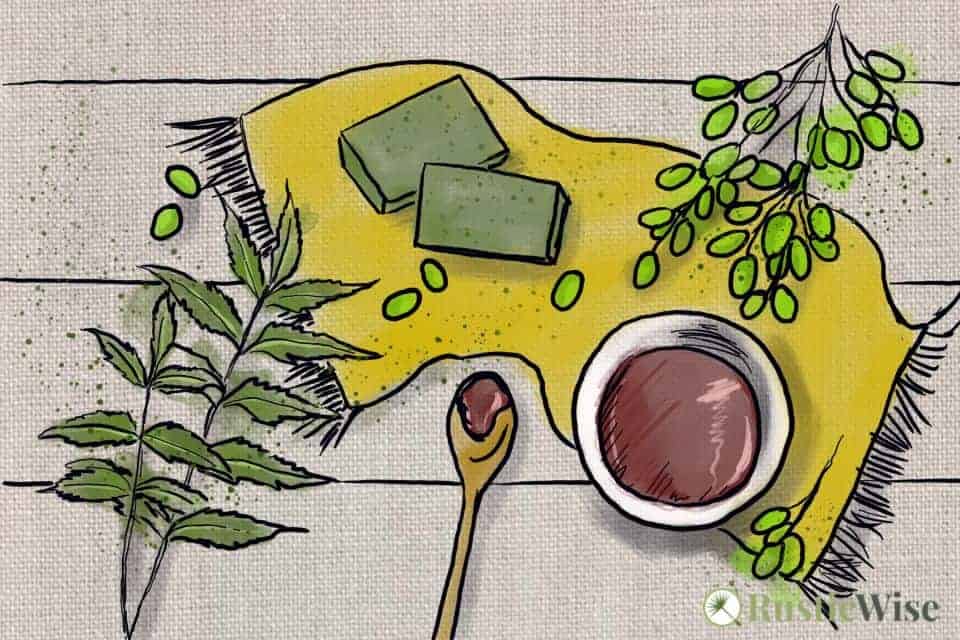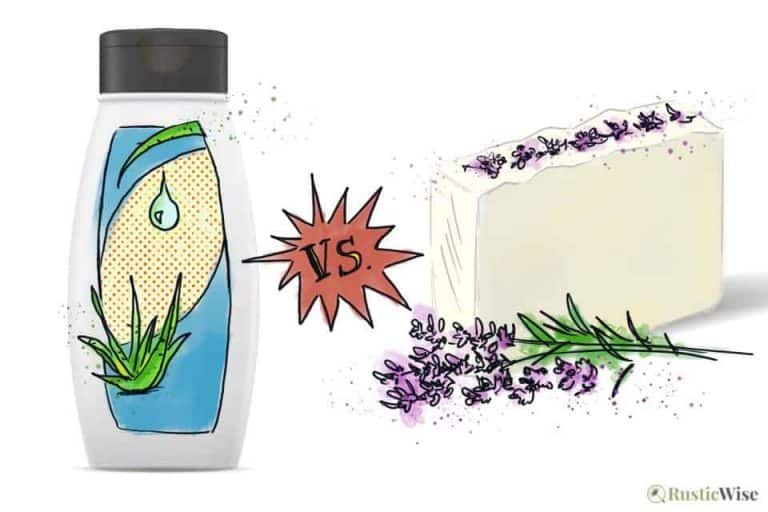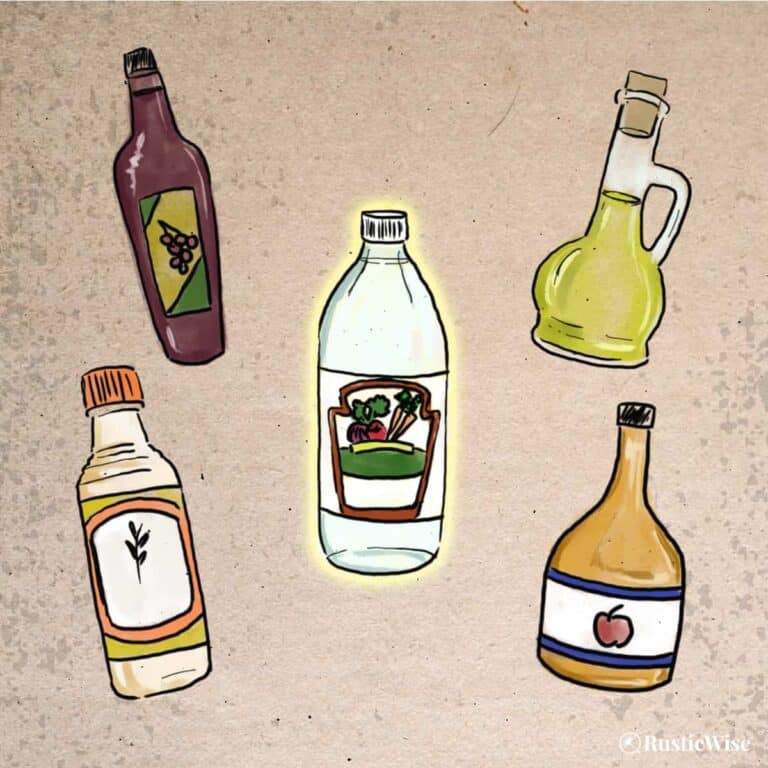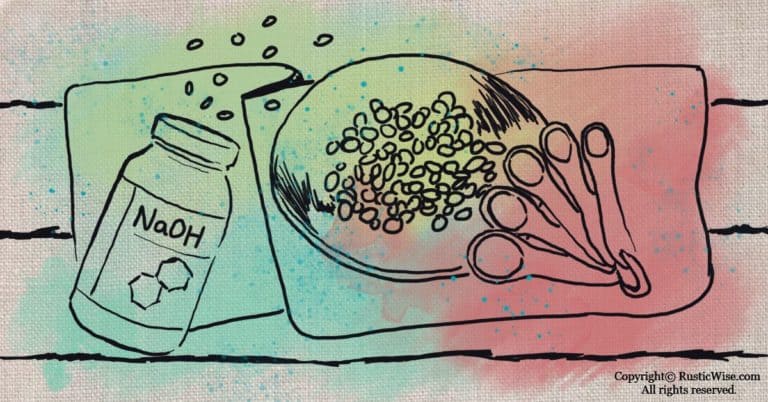Neem Oil in Soapmaking: A Soothing Moisturizer for Dry Skin
RusticWise is supported by its readers. When you purchase through links on our site, we may earn an affiliate commission. As an Amazon Associate, we earn from qualifying purchases. Thank You!
Packed with antioxidants, vitamin E, and essential fatty acids, neem oil has great moisturizing properties. Consider using neem oil in soapmaking if you’re looking for a skin nourishing oil that soothes dry, itchy skin.
If you’ve ever smelled neem oil, you won’t soon forget its strong pungent aroma (think garlic and nuts). It’s a smell that most people either love or hate. When adding neem oil to your next batch of handmade soap, remember that a little goes a long way.
Read on to learn more about the benefits of neem oil, the properties of neem oil in soapmaking, and how much to add. Let’s get started!
What exactly is neem oil?
Neem oil is extracted from the fruit seeds of the neem tree (Azadirachta indica). The neem tree is sometimes known as nim, or margosa, and is native to India and parts of South Asia. Nowadays, you’ll find the neem tree in Central and South America, as well as areas in Africa and the Caribbean.
With antifungal and antibacterial properties, it’s perhaps no surprise that the neem tree is used for traditional medicines and cosmetics. Most parts of the neem tree (including the bark and leaves) are used in Ayurvedic medicine or folk remedies. The leaves are used to manage blood sugar levels and as a remedy for diabetes.¹
In skincare and cosmetics, shampoos made of neem help keep dry scalp and dandruff in check. Neem oil has been a useful application on skin for centuries helping to soothe acne, eczema, psoriasis, and even athlete’s foot. You’ll also find this oil in some commercial toothpastes.¹
Neem oil also contains an active component called Azadirachtin which acts as a natural insect repellent. You’ll find it listed as a key ingredient in over 100 pesticides on the market.²
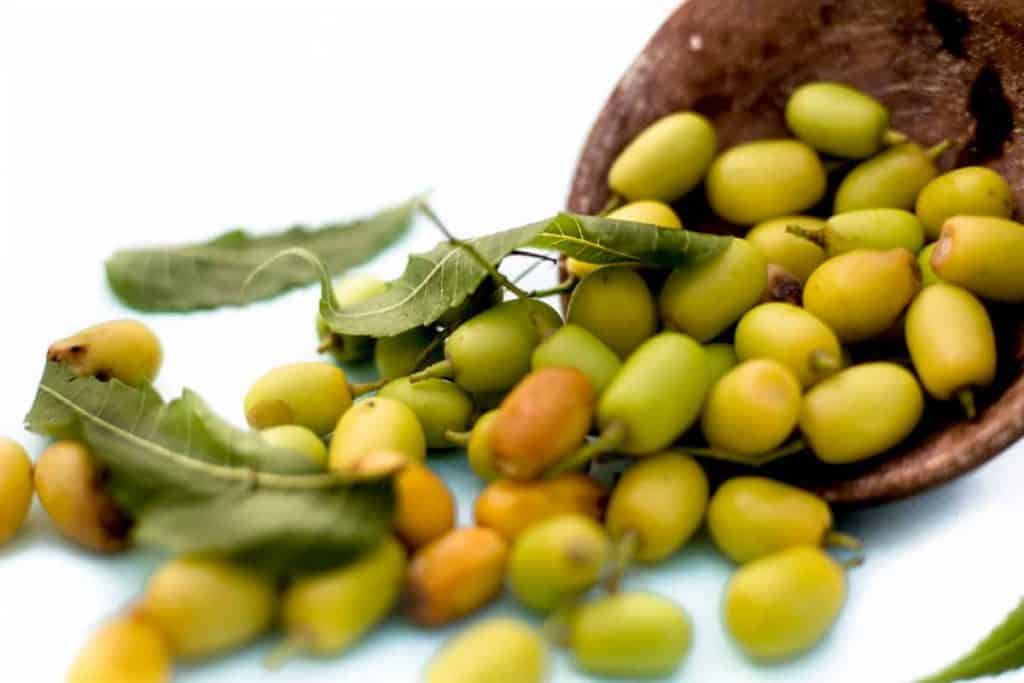
Neem oil safety
Neem oil, along with its bark and leaves, is not safe for consumption by pregnant women, breastfeeding women, or women trying to conceive.
Tip: Neem oil that’s applied undiluted directly to skin may cause skin irritation. Try testing a small amount of neem oil on skin first. It’s best to apply it using a carrier oil, or as part of a cold process soap recipe.
Neem oil soap benefits
Neem oil is used to soothe dry, itchy skin—perfect for those with eczema, psoriasis, or sensitive skin.
You might like
Neem Oil (4oz), USDA Certified Organic, Cold Pressed, Skin
- CLEAR SKIN: Neem Oil helps clear blemishes and prevent future breakouts. This helps restore moisture & promote soft, supple skin. It can also help calm temporary redness and itchiness due to dryness, eczema, dandruff & more.
- SOFTEN & SMOOTHER SKIN: Neem Oil’s unique underlying property is rich in antioxidants and essential fatty acids and Vitamin E. It is the perfect nourishment for your skin, hair, and nail. Daily usage can help diminish the appearance of wrinkles, fine lines, and aging.
Found on Amazon
Check Current Price
Those in Canada and the UK should be taken to the product listing in your region.
Neem oil properties in soap
When buying neem oil for natural soap, look for bottles labelled as 100 percent pure, organic, or cold-pressed. It comes in solid or liquid form with colors ranging from light to dark golden brown. You can find neem oil online from a variety of soap supplies wholesalers.
The distinct strong, pungent smell (garlicy and nutty) will discourage most people from using too much neem oil in soap.
When used in bar soap, neem oil creates a stable, creamy lather. It also adds hardness to soap and is highly conditioning.
Here’s a closer look at the properties of neem oil in soap:⁵
- Hardness: 39
- Cleansing: 2
- Conditioning: 58
- Bubbly lather: 2
- Creamy lather: 37
Now let’s look at the fatty acids in neem oil:
- Lauric: 0
- Myristic: 2
- Palmitic: 21
- Stearic: 16
- Ricinoleic: 0
- Oleic: 46
- Linoleic: 12
- Linolenic: 0
Very high in oleic fatty acids, you’ll get great skin conditioning properties when using neem oil in soap—just don’t expect big bubbly lather. The palmitic acid provides stable lather with a long shelf life.
How much neem oil to use in cold process soap?
Use between 3 and 6 percent neem oil in your cold process soap recipes.
The color and smell will affect your finished bar of soap, so it’s best to use sparingly. Too much neem oil in soap will smell strongly (an off-putting smell for many people), and may irritate the skin.
Some soap makers suggest using up to 20 percent neem oil to get more skin nourishing benefits. You could always experiment with a small batch to see how you like it. Keep in mind that when used in larger quantities, neem oil will speed up trace.
If you decide to go unscented, note that the neem oil scent will still be detectable in the finished soap. Try minimizing the distinct odor with an essential oil with a full-bodied scent.
However, like all scents in homemade soap, the smell of neem oil will also fade.
Suggested essential oils to use in your neem oil soap bar
To counter or complement the earthy, nutty aroma of neem, try one, or a combination of the following essential oils:
- Cedarwood
- Cyprus
- Eucalyptus
- Juniper berry
- Lavender
- Lemon
- Peppermint or spearmint
- Rosemary
- Sage
- Tea tree
Homemade shampoo bar recipe with neem and nettle
Here’s a soothing neem oil shampoo soap recipe adapted from Soap Making Magazine.⁶ This cold process shampoo bar uses the calming soothing properties of nettle together with the conditioning properties of neem.
While this natural shampoo is suitable for all hair types, it’s especially great if you have oily hair, and/or have eczema or psoriasis. The stinging nettle powder has anti-inflammatory properties; the neem oil brings on the conditioning.
If this is your first time making cold process soap, please read up on lye safety first! As this is a shampoo bar, it has a lower lye ratio and higher superfat for increased conditioning properties.

Ingredients:
Lye mixture:
- 215 grams cold distilled water
- 118 grams sodium hydroxide
Solid Oils:
- 225 grams coconut oil
- 225 grams shea butter
Liquid oils:
- 225 grams olive pomace
- 135 grams castor oil
- 100 grams avocado oil
- 15 milliliters (1 tablespoon) neem oil
Other ingredients:
- 7.5 milliliters silk amino acid
- 6.75 grams nettle powder
Supplies and equipment:
- A heat-safe measuring jug
- Two stainless steel saucepans
- Digital kitchen scale
- Immersion blender
- A heat-safe whisk or non-reactive spoon
- Spatula
- Soap mold (lined with silicone or greaseproof paper)
- Safety glasses and gloves
- A blanket or large towel
- Muslin cloth or cheesecloth (to strain your nettle infusion)
Steps and instructions
Prepare nettle infusion
At least 24 hours before you make your soap, prepare a nettle infusion by combining the nettle powder with the olive pomace. For a better infusion, try warming the olive oil slightly. Strain before use.
Make lye solution
Put on your safety equipment (eye goggles and gloves). Measure the distilled water using a heat-safe jug. Slowly add the sodium hydroxide to the water. Use the whisk to continually stir until the sodium hydroxide has fully dissolved. Be careful as the lye solution gets very hot—up to 200 degrees Fahrenheit (93 degrees Celsius).
Combine oils
While the lye solution is cooling, measure, combine, and melt the solid oils and butter using a double boiler. Once liquid, remove from heat and add the remaining liquid oils, including the neem.
Bring to trace
Once the lye mixture has cooled and is of similar temperature to the melted oils, carefully add the lye to the oils. Use an immersion blender (stick blender) to combine the soap batter until it thickens and turns opaque. Do a drizzle test to see if the soap mixture leaves a mark on the surface. If it does, you’ve reached trace.
Pour into mold
Pour the soap batter into prepare mold.
Allow it to set and cure
You may find it helpful to insulate the mold with towels and leave at room temperature for at least one day. Once the soap has completely cooled and hardened, it can be unmolded and cut into bars. If bars are too soft, allow it to set for two or three more days.
To further harden the soap bars, let them cure for 3 to 4 weeks in a well-ventilated room. You’ll get a longer lasting bar this way.
Enjoy luscious locks with your all-natural shampoo bar!
Related questions
What’s a substitute for neem oil in soapmaking?
It can be tricky when trying to substitute oils in soapmaking. Neem oil is high in oleic fatty acids and palmitic acids—try to find an oil with similar properties. There are a few soft oils with similar fatty acid profiles as neem oil you could try using as a substitute. These include pumpkin seed oil or tamanu oil (kamani).
How do you use neem oil soap for plants?
Neem oil is a common ingredient in many plant-derived pesticides and contains Azadirachtin, an active compound that repels insects. An easy way to make a DIY pesticide is to combine a few drops of neem seed oil and liquid dish soap together with warm water. Shake well to mix and spray onto plants that are experiencing pest problems.
New to making soap? 🧼❓
👉We have a fantastic overview on the whole soapmaking process here: read our Timeless Guide To Soapmaking.
If you would like to see our soapmaking posts organized by topic type, see our Soapmaking Collection.
Would you like more timeless tips via email?
Fun tips to help you live an independent, self-sustaining lifestyle. Opt-out at any time.


References
- Britannica, Neem tree, https://www.britannica.com/plant/neem-tree. Accessed November 2021.
- National Pesticide Information Center, Neem Oil General Fact Sheet, http://npic.orst.edu/factsheets/neemgen.html. Accessed November 2021.
- Jay, Kitty (15 May 2019). “Can You Use Neem Oil for Skin Care?“, Healthline. Accessed November 2021.
- Jose Francisco Islas, Ezeiza Acosta, Zuca G-Buentello, Juan Luis Delgado-Gallegos, María Guadalupe Moreno-Treviño, Bruno Escalante, Jorge E. Moreno-Cuevas, An overview of Neem (Azadirachta indica) and its potential impact on health, Journal of Functional Foods, Volume 74, 2020, 104171, ISSN 1756-4646, https://doi.org/10.1016/j.jff.2020.104171. (https://www.sciencedirect.com/science/article/pii/S1756464620303959)
- SoapCalc, Soap Calculator, http://soapcalc.net/calc/SoapCalcWP.asp. Accessed November 2021.
- Soap Making Magazine, Neem & Nettle Shampoo Bar, https://www.soapmakingmagazine.co.uk/blog/index.php/2019/07/31/neem-and-nettle-shampoo-bar/. Accessed November 2021.

Author: Theresa Tesolin
Theresa is co-founder of RusticWise. She helps people unleash their inner DIY spirit by encouraging them to get dirty and make or grow something from scratch.

